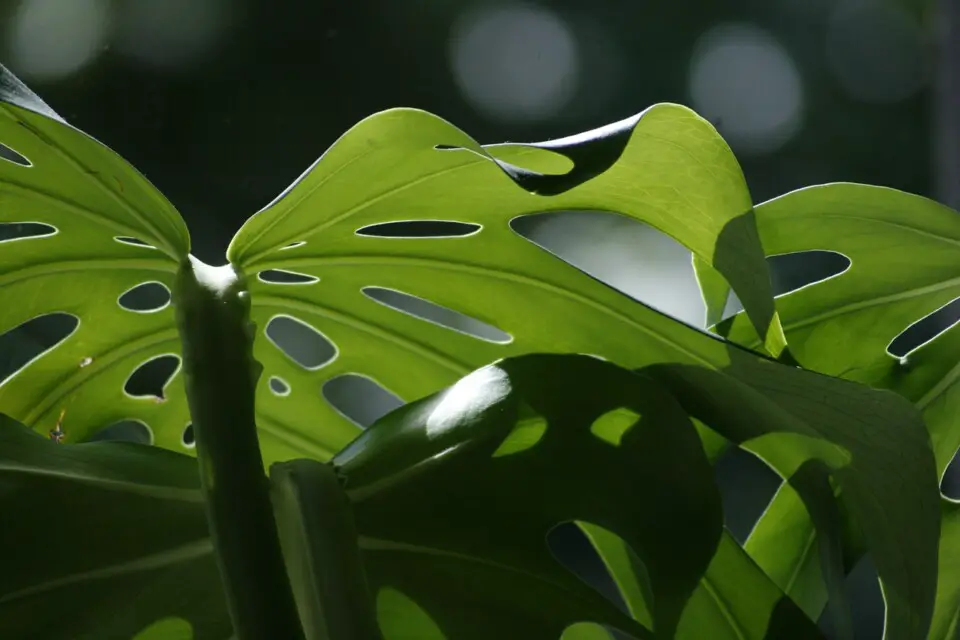Some links in the post are affiliate links and I get a commission from purchases made through some links found in the post.
Whenever I share a monstera cutting with someone who has not grown a monstera before, I always follow up with a lot of advice.
It ranges from lighting to watering down to humidity regulation. And it makes it easier for the budding monstera plants to know what to expect in their journey.
One thing I try to remember is the color of the plants. Most people have become accustomed to dark green monstera leaves and expect the same of their plants.
And while this is the norm, it does not always hold – especially for young leaves. So, I tell the new plant parents to take it easy if their new monstera leaves are light green. In time, the leaves should take on a dark green hue.
So, what causes a light green hue in young monstera leaves? And is there anything that can make mature leaves turn light green?
The reasons your monstera is turning light green is due to your leaf needing more light and not getting enough watering Other issues include being rootbound and lack of nutrients.
A young monstera leaf will start out light green and darken with age as the chlorophyll in the leaves increase.
I cover these crucial topics in this guide.
Why Are Young Monstera Leaves Light Green?
 A lot can happen when a monstera is developing new leaves. First, the leaves come out curled inwards, which can be a bit of a shock to new parents.
A lot can happen when a monstera is developing new leaves. First, the leaves come out curled inwards, which can be a bit of a shock to new parents.
Secondly, the leaves take on a light green hue contrasting with the other monstera leaves. And if I have a mature plant with young leaves, I usually show this to anyone taking a cutting so that they can visualize these changes.
Let’s start with normal leaf growth. The monstera leaves come out folded and remain so for a week or more.
If the conditions are ideal (light, humidity, and temperature), the leaves unfold and start taking on a mature size and hardening.
Over time, the leaves fenestrate, giving rise to the splits characteristic of these plants (a pattern only visible in mature plants). And once the leaves attain mature sizes, they start darkening as the chlorophyll in the leaves increases.
There is a scientific explanation behind all this. The green coloring matter in leaves, aka chlorophyll, is more present in mature leaves.
That’s because they are responsible for making the food that gives the plant energy to produce and maintain leaves.
The young leaf will, at the time, depend on the mature leaves for food and energy and will thus not need a deep green hue. As the leaf matures, it starts developing more chlorophyll, so it can also contribute to photosynthesis.
Why Are My Monstera Leaves Turning Light Green?
Your monstera leaves only remain light green in their developmental stages. But once they mature, they should have a dark green hue.
However, sometimes they do not achieve this hue. Or achieve it and lose it down the line. What causes these issues? Please refer to the possible causes below:
1) The Monstera Needs More Light
The presence of light imparts energy on your monstera leaves and helps them convert water and nutrients into food. And all this is possible when the plant has adequate chlorophyll, which is evident in the dark green hue of the leaves.
However, when the plant gets poor light, it cannot make food. So, it puts some activities on hold and instead focuses on growing longer or leaning towards the light.
Such a plant will not only have light green mature leaves but may also show:
- Yellowing on the leaves,
- Poor or small leaf development,
- Slowed or no growth,
- A high rate of water retention in the soil despite a regular watering schedule
Such a plant lacks energy, and its chlorophyll production will thus suffer. If you do not act fast enough, the plant will deplete its energy reserves and could die if it does not reach a source of light in adequate time.
How Can You Fix Lighting?
The first thing to remember is that the monstera grows in filtered light in the wild. Thus, it does not need bright and direct light.
Instead, it can survive on bright and indirect light. Secondly, the plant needs access to at least 10 hours of this light. That said, you can nurse it back to health by:
- Moving the plant near an east or south-facing window where it can get adequate light exposure. Avoid the west-facing window as the sun’s rays in the afternoon are often too harsh on the plant and can damage its leaves.
- Adding artificial light near the plant if the natural light is inadequate. That helps you meet the 10-hour minimum and thus encourages photosynthesis.
- Changing the plant location if it shows signs of too much light exposure, like browning on the edges, or drooping due to excessive water loss, and
- Rotating the plant every week to allow all its sides to get adequate light exposure.
In two to four weeks, the plant will regain its health and start producing more chlorophyll to help it keep making food.
Always keep the plant in such lighting conditions, and move it as the seasons change, and you will hardly ever have a lighting issue.
2) The Monstera Has Watering Issues
The monstera is native to tropical regions, and its water needs are thus a point of concern. You can fall short in two ways:
The Monstera Needs More Water
 A stressed plant will hardly produce enough chlorophyll, and this might show in its leaves.
A stressed plant will hardly produce enough chlorophyll, and this might show in its leaves.
That’s because the plant will focus on surviving, which it can do by slowing down other plant activities, drooping to reduce the surface area exposed to the sun, etc. Underwatering can occur because:
- You do not follow a regular watering schedule, and thus the soil remains dry for days or weeks,
- You have used a potting mix with poor water retention, or
- The temperatures are high, e.g., in the summer, and you’re using the same watering regimen.
These factors deprive the plant of water such that it loses more water to the environment than it takes up via its roots.
The monstera leaves, unable to produce food, take on a light green color. And if you do not step in, the leaves can turn yellow and start falling off the plant.
The Monstera Needs Less Water
Underwatering is the less serious watering issue. Overwatering can kill your plant even before you are aware of its existence.
Here is how it works. When a monstera is overwatered, its roots sit in water. And because the water is more than the monstera needs, the plant does not use most of it.
That leaves the roots in the oxygen-deprived water for a long time, creating an ideal home for fungal diseases. These diseases start attacking the roots and destroying the base of the plant.
Eventually, the monstera begins dying from the inside, resulting in issues such as slowed growth, paling, then yellowing of the leaves, and falling of the leaves.
Overwatering can result from:
- Using a potting mix with too much water retention,
- Not following a regular watering regimen, and
- Using the same watering schedule for all the seasons.
Your monstera is better off underwatered than overwatered.
Dealing with Watering Issues
You can deal with and avoid the said watering issues by:
- Following a regular watering schedule. Do not water the monstera until its top two inches of soil feel dry. If you’re unsure how to check, you can do so with a finger or use a moisture meter.
- Ensuring the soil mix is well-draining such that it balances drainage and retention,
- Altering the watering schedule based on the seasons, e.g., cut back on the colder months when the water usage reduces.
If your monstera has suffered root rot, you will need to remove it from its current pot and remove the affected parts using a sharp knife.
Then treat the remaining roots with a fungicide and repot the monstera in a fresh potting mix in another pot. Water it and allow the excess water to drain before locating the plant in a spot with bright and indirect light exposure.
The plant should start regaining its color two to three weeks after fixing the watering issue.
3) The Monstera is Rootbound
At some point, the monstera will outgrow its current pot such that its roots will have no choice but to:
- Twirl around each other,
- Come out of the drainage holes, or
- Seek space at the top of the soil.
These signs indicate the plant is rootbound and has no more space for the roots to grow. And such a plant does not have access to enough soil to provide it with water and nutrients.
Thus, the paling of the leaves is only the start of a drawn-out series of issues. You will need to ascertain the presence of the root binding and deal with it.
Dealing with the Rootbound Monstera
Here’s how you repot your monstera:
- Ascertain the plant is rootbound by watering it the day before. Then slide it out of the pot and check the state of the roots. If they are cramped, your plant needs more growing space.
- Find a pot 2 inches bigger than the current one and fill it to a third of its depth with fresh well-draining potting soil.
- Place the monstera in the potting soil, fill the pot with the rest of the soil, and water the plant.
Your plant should get accustomed to its new home in a few days or weeks and will soon have dark green foliage.
4) Your Monstera Needs More Nutrients
Water, light, and (drumroll) nutrients! Your monstera relies on nitrogen to develop chlorophyll and healthy leaves. At first, when you plant your monstera, it will derive the nitrogen from the potting mix.
But as time goes by, this nutrient will become depleted, and your monstera will thus struggle with creating chlorophyll. Therefore, its growth will take a hit, and its leaves will turn a light green.
Increasing Nitrogen in the Potting Soil
There are two ways you can go about this:
- You can repot the monstera every two years and give it a fresh mix of potting soil. In this case, it can rely on the nutrients in the soil mix and grow quite well.
- You can fertilize it during its active growing season using a diluted balanced liquid 20-20-20 feed. Do this every month, and the plant should be okay.
Please note that overfertilization can harm your plant. Thus, you cannot attempt the measures below concurrently. Choose one and stick with it. And always give your plant a break to allow it to use the feed.
You may also like: How to care for a monstera
Final Thoughts
 Did you know? The monstera can produce new leaves if kept at the right temperatures all year round.
Did you know? The monstera can produce new leaves if kept at the right temperatures all year round.
If you can maintain a 70-degree range with at least 50% humidity, you can look forward to new leaves throughout the changing seasons.
And if the plant has enough water, light, and nutrients, its leaves will not lose their aesthetically pleasant dark green hue.
Happy Gardening!


